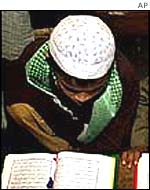Inside the Madrasas

En 1947, lorsque le Pakistan est devenu indépendant, le pays comptait 245 madrassas (école coranique). Il y en a aujoud'hui 6,870 (2001) avec quelque 800,000 étudiants.L'auteur, William Dalrymple, les a visités.
Livres analysés dans cet article
Islamic Education and Conflict: Understanding the Madrassahs of Pakistan
by Saleem H. Ali
Paper presented at the US Institute of Peace, June 24, 2005
Globalized Islam: The Search for a New Ummah
by Olivier Roy
Columbia University Press,349 pp., $29.50
The War for Muslim Minds: Islam and the West
by Gilles Kepel, translated from the French by Pascale Ghazaleh
Harvard University Press,327 pp., $23.95
Understanding Terror Networks
by Marc Sageman
University of Pennsylvania Press, 220 pp., $29.95
Landscapes of the Jihad: Militancy, Morality and Modernity
by Faisal Devji
Cornell University Press,240 pp., $25.00
Bastions of the Believers: Madrasas and Islamic Education in India
by Yoginder Sikand
New Delhi: Penguin India, 400 pp., RS395.00
Extraits
In this case, as in so many others, the link between madrasas and international terrorism is far from clear-cut, and new research has been published that has challenged the much-repeated but intellectually shaky theory of madrasas being little more than al-Qaeda training schools. It is certainly true that many madrasas are fundamentalist and literalist in their approach to the scriptures and that many subscribe to the most hard-line strains of Islamic thought. Few make any effort to prepare their students to function in a modern, plural society. It is also true that some madrasas can be directly linked to Islamic radicalism and occasionally to outright civil violence.
Extraits
It is estimated that as many as 15 percent of Pakistan's madrasas preach violent jihad, while a few have been said to provide covert military training. Madrasa students took part in the Afghan and Kashmir jihads, and have been repeatedly implicated in acts of sectarian violence, especially against the Shia minority in Karachi.
As the French scholar Gilles Kepel puts it, the new breed of global jihadis are not the urban poor of the third world so much as "the privileged children of an unlikely marriage between Wahhabism and Silicon Valley, which al-Zawahiri visited in the 1990s. They were heirs not only to jihad and the umma but also to the electronic revolution and American-style globalization."
It is certainly true that many madrasas in Pakistan have an outdated curriculum: some still teach geometry from Euclid and medicine from Galen. Emphasis is put on the rote learning rather than the critical study of the Koran, and considerable prestige is still attached to becoming a hafiz-knowing the Koran by heart. Deobandi ma-drasas teach that the sun revolves around the earth and some even have special seating for the invisible Islamic spirits, the djinns.[10] This is, however, by no means the case with all ma-drasas, some of which are surprisingly sophisticated.

0 Comments:
Publier un commentaire
<< Home